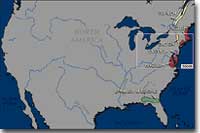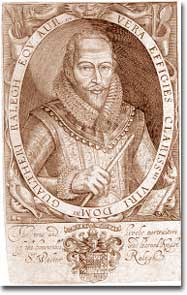
2. Britain in the New World

Before the English arrived in North America, the Spanish, the Dutch, the Swedish, and the French were already on the scene. This map shows the areas claimed by these European countries.
Most modern American citizens consider Great Britain to be their European "parent" country.
However, by the time British arrived in the New World and established their first permanent settlement at Jamestown in 1607, much of the continent had already been claimed by other European nations.
All of the modern Southwest, including Texas and California, had been peopled by Spanish settlers for about a century. The entire expanse of land between the Appalachian Mountains and the Rocky Mountains had at one point been claimed by France.
Many factors contributed to Britain's tardiness. England was not the most powerful European nation in the 16th century. Spain was most influential. Along with Portugal, Spain dominated New World exploration in the decades that followed Columbus. France, the Netherlands, and Sweden all showed greater interest in the Western Hemisphere than England did.
Late Expectations

One of England's most adventurous sea captains, Sir Walter Raleigh was granted a charter in 1584 to seek out new lands.
A voyage by John Cabot on behalf of English investors in 1497 failed to spark any great interest in the New World. England was divided in the 1500s by great religious turmoil. When Henry VIII broke with the Catholic Church in 1533, decades of religious strife ensued. Finally, under Henry's daughter Elizabeth, the English were prepared to stake their claims.
Although England was an island and therefore a seafaring nation, Spain was the undisputed superpower of the seas in the 16th century. Many of England's adventurous sea captains found that plundering Spanish ships was a far simpler means of acquiring wealth than establishing colonies.
Sea Dogs and the Spanish Armada
These sea dogs, including Walter Raleigh, Francis Drake, and the infamous John Hawkins, helped provoke the eventual showdown between Elizabeth I's England and Philip II's Spain.
Sea dogs
Sea dogs were English mariners of the Elizabethan era employed by the queen to harass the Spanish fleets and establish a foothold in the New World. Among the most prominent sea dogs were Francis Drake, John Hawkins, Humphrey Gilbertand, and Walter Raleigh. These sea captains possessed exceptional maritime and military skills as well as a burning desire for capturing Spanish treasure.
Philip was certain that his great fleet of ships would put an end to England's piracy. In 1588, one of the greatest turning points in world history occurred when Spain's "invincible" armada of 130 ships sailed into the English Channel. Despite their numerical inferiority, the English ships were faster and easier to maneuver than the Spanish fleet. With the aid of a great storm, Elizabeth's ships humiliated Philip's navy, which returned to Spain with fewer than half their original number.
This battle marked the beginning of the end of Spain's domination of Europe and the Western Hemisphere. More importantly for England, it marked the dawn of the era of permanent English settlement of the New World.





